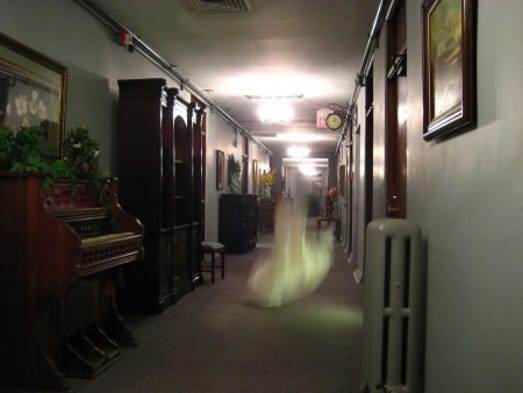
On a fuzzy green screen, you see a T-shirted man pointing a small electronic recorder toward a murky corner.
He swivels his head toward the camera, his eyes glowing like orbs.
“This is where a figure of a small girl has been sighted on numerous occasions,” the man says in a hushed voice. “We’re hoping she’s in the mood to answer some – holy (bleep), something touched me!”
The frame jumps and blurs before focusing on the man’s face and his look of shock.
And it’s largely ghost-hunting theater, according to one of Phoenix’s longtime paranormal investigators.
More: Arizona haunted hotels: Check into these 10 frightful places
‘It never happens like that’
“Most of that stuff on TV is bunk,” Vincent Amico said. “It never happens like that.”
Amico has the experience to back up his claim. He’s been investigating the paranormal for 15 years, and in 2014 he and his wife started AZ Paranormal Investigations and Research Society. Amico also leads tours for Haunted Historians, which attracts fans of the many ghost-hunting TV shows.
And that’s where these un-reality shows pose problems, he said. Those fans expect to see evidence of the afterlife, from an empty rocking chair moving by itself to shadowy apparitions coalescing in corners.
Such eerie incidents are extremely rare and easily fabricated.
“A guy says he felt something touch him, or you hear a door slam off camera,” Amico said. “That’s the easiest stuff to fake. There’s no way to prove he wasn’t touched, or that someone off camera didn’t slam the door.”
Specter-chasing TV shows caught on in 2004 with SyFy’s “Ghost Hunters,” which lasted 12 years before broadcasting its last episode in October 2016. Similar shows followed in its glowing green footsteps, including Travel Channel’s “Ghost Adventures” and “Haunted USA.”
The recipe is the same. Investigators equipped with cameras and various ghost-detecting devices spend a night in a hotel/house/abandoned warehouse said to be haunted. Before the sun rises, they’ve seen/spoken with/found evidence of the afterlife. Everyone goes home shaken.
Amico said the shows are misleading at best, fake at worst. A typical paranormal investigation takes several visits over weeks or months, he said, and 99 percent of that time would set off every tedium monitor in the place if such a thing existed.
The “night in a haunted house” scenario is necessary to keep viewers interested, though it’s highly unlikely that’s how the investigation unfolded.
Jay Yates, who with his wife Marie have been featured on several TV and radio shows dedicated to paranormal investigations, said that in some cases cameras are set up weeks before the ghost hunters themselves arrive.
“I wish that ghosts showed up on demand but it doesn’t work that way,” he said. “Many of these ghost-hunting shows are not evidence-driven, but more based upon experiences from the cast and crew, not concrete evidence always.”
Amico also takes issue with the way hunters interpret those static-filled electronic voice phenomena (EVP) recordings.
More: Arizona ghost tours: Spooky haunts in Jerome, Bisbee, Prescott, Tucson, and Phoenix
Viewers are familiar with the setup. The experts either place an EVP recorder in an empty room (the recording is analyzed later) or use it to “interview” any spirits interested in chatting. Since ghosts have no vocal cords, they use their energy to electrically manipulate sound that can be picked up by EVP recorders, paranormal investigators say.
In most cases, words are almost impossible to make out amid the static and buzzing, and may be nothing more than background sounds, Amico said. That changes once ghost hunters put words to those sounds, interpreting them as voices from beyond the grave.
A fluctuation in static, for example, can be translated as, “Get out.” Or “He’s here.” Or any number of things, most of the eerie.
“It’s all about suggestion,” Amico said. “Let’s say he tells everyone he hears, ‘Help me.’ When it’s played again, that what you hear. ‘Help me.’ But it’s only because he planted it in your head.”
The on-screen investigators also can manipulate devices that detect changes in the electromagnetic field, believed to indicate the presence of spirits, Amico said.
The electromagnetic field (EMF) sensor features a series of lights that illuminate one after another. The more lights, the stronger the electromagnetic change.


